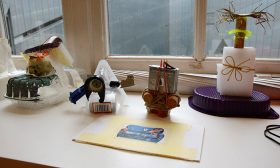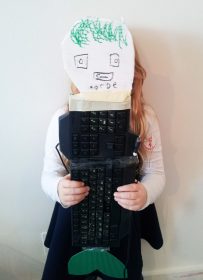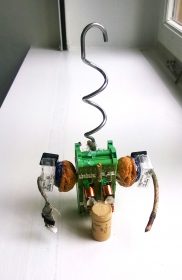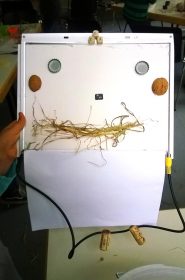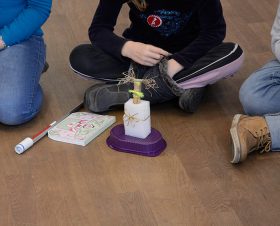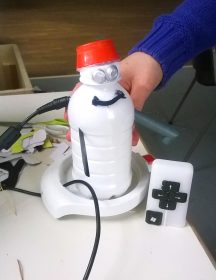Hebrew newspapers and colorful cloth remnants are lying on the floor. On the table there are wires, chains, old electrical equipment, cooking pots, used eyeglasses cases, and buttons, just to name a few of the household items spread around. Everything that would otherwise be thrown away gains a whole new meaning at the Golem Atelier.
Aside from everyday objects there are also a lot of natural materials, such as chestnuts, straw, dried leaves, and pine cones, whose scent reminds me of walks in the woods.
Inspired by a visit to our current exhibition GOLEM (more about the exhibition on our website), our smallest visitors, kids five years old and up, now have an hour to give shape to their ideas and wishes and create their very own golems.
I’m delighted by so many excited faces and the children’s interest in what’s going on. “Look at the materials, pick them up, and experiment with them! You may decide yourselves what your golem will look like and what it will be able to do,” explains the workshop leader.
Lots of little hands reach out at the plethora of objects and begin building their golems. Some kids go straight for the materials. Others are indecisive at first and only choose their favorite object after much thought. I ponder shortly what in the world my golem should be able to do? Should he be able to fly? Read thoughts? Make magic? Or all of the above?
The central issue is the pleasure that children have in freely experimenting, and accomplishing something. “The process of creating is more important than the artistic final product,” says the Israeli artist Anat Manor (http://anat-manor.net). She conceived of the workshop “Golem to go! A legend from garbage,” because she’s interested in experimenting with everyday objects herself, and thus in how to address the real world again, and her own senses.
The basis for the workshop is a pedagogical concept from the Jewish-Israeli educator Malka Haas (born in 1920 in Berlin). In a documentary film about the kibbutz Sde Eliyahu, Life is Holistic (2011), Manor describes Haas’s integrated approach based on actually doing and experimenting.
The golem lab makes space for exactly this creative process of making. After industriously crafting, gluing, and building, the making part is done and a bunch of extraordinary creatures are romping around next to each other, to be introduced in turn with all their peculiarities and uniqueness:
“My golem is called Flower and is a work golem. The only thing he can’t do is speak,” says one proud owner. A very 21st century computer golem with a remote control, a flying golem named Techno, and a happy golem — who’s always happy, of course, and likes to give fashion advice but has trouble walking, are all part of the illustrious group. “Mine is an It, it’s called Hooch because of his tousled hair. It can turn things into gold. But it can’t jump,” explains the little girl who created Hooch.
Not just the children’s eyes are beaming but mine too: they got bigger and bigger over the course of the workshop. I am simply astonished at the imagination that I’m encountering, the free thinking that’s so often easier for kids than for adults, the love of detail with which these golems are being built.
Hm, I know what I really want: a creative golem, please!
After experiencing the golem workshop Aylin Uysal now sees tons of things on the street that could be used to build a golem
For those interested in a Golem Workshop for school or after-school groups, further information can be found here: https://www.jmberlin.de/en/workshop-golem.
